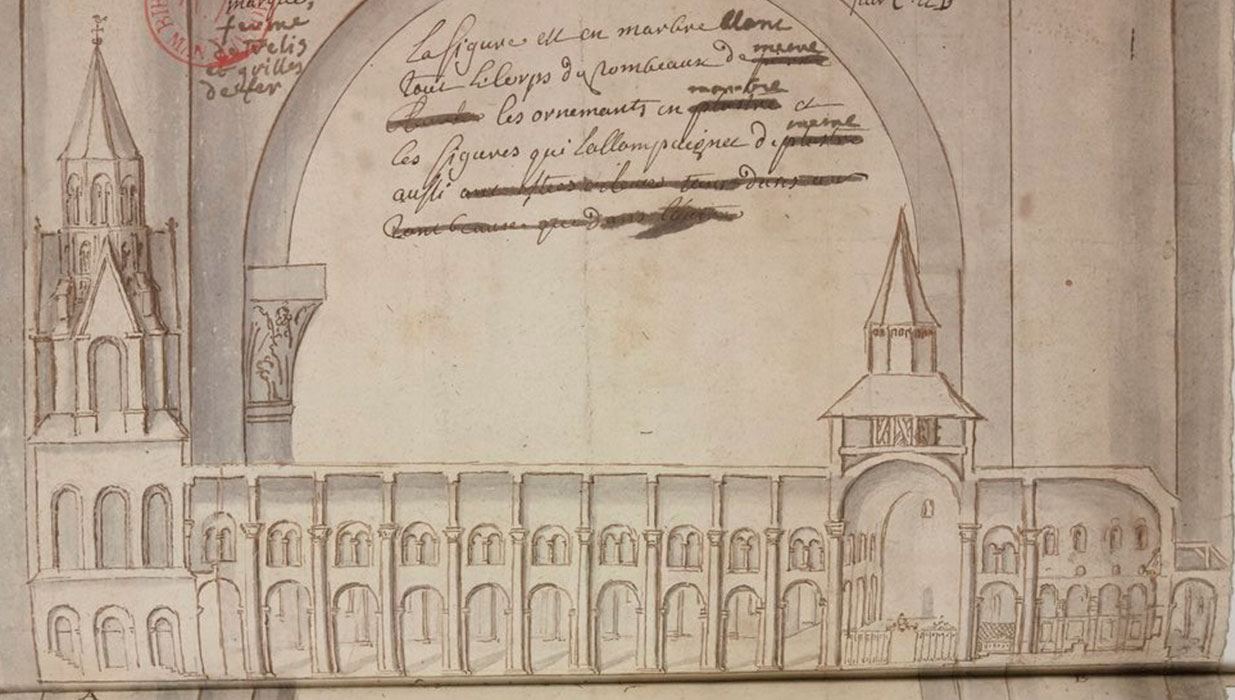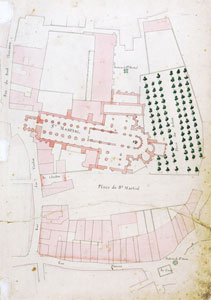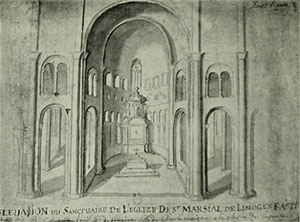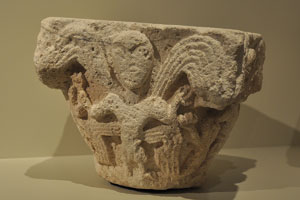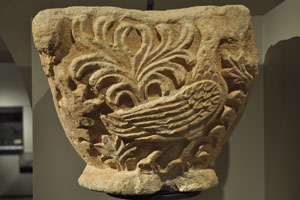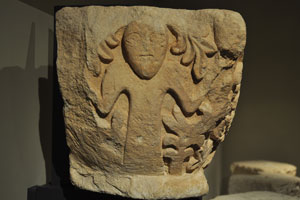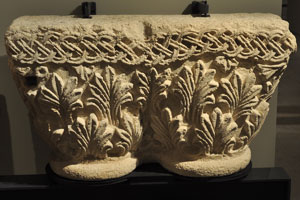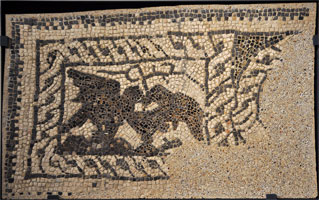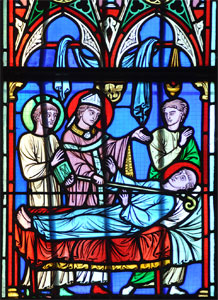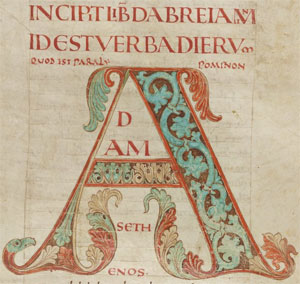The origins of the monastery of Saint-Martial de Limoges are sparsely documented and rely mainly on ancient narratives and chronicles, particularly that of Adémar de Chabannes (c. 988–1034), a monk from the same monastery. It is not until the 9th century that more reliable references and documentation begin to appear. At the same time, archaeological research has confirmed religious activity at the site dating back to the 3rd and 4th centuries.
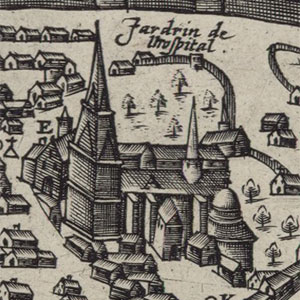
Detail of Totius Lemovici et confinium provinciarum... (1594)
Bibliothèque nationale de France
The monastery developed around the tomb of Saint Martial (or Marcial) of Limoges, considered the first bishop of the diocese. According to tradition, Martial arrived in the city in the mid-3rd century or, more likely, at the beginning of the 4th century. He is said to have been sent from Rome by the Pope for evangelization purposes, as part of a group of seven missionaries tasked with converting Gaul (Gatien, Trophimus, Saturnin, Paul, Denis, Austromoine, and Martial). His tomb became a place of worship, cared for by a community of clerics. This community is first documented in the testament of Saint Aredius, dated to the year 572.
It is likely that these clerics were connected to the cathedral of Limoges. In 848, they received permission from Charles the Bald († 877) to adopt the Rule of Saint Benedict, following the reform led by Benedict of Aniane, despite episcopal opposition. Around the saint’s tomb, a crypt was built, adjoining the basilica of Saint-Pierre, along with a church used for clerical ceremonies. In the mid-9th century, a new church was constructed and dedicated to the Savior (Saint-Sauveur).
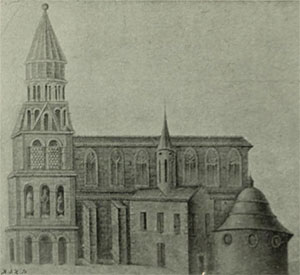
Interpretation of the 18th century church
Published in L’abbaye de Saint-Martial de Limoges (1901)
The abbey suffered during a Norman invasion, likely in 888, which forced the monks to flee and temporarily take the relics of Saint Martial with them. The church was rebuilt in the mid-10th century after a fire and was once again reconstructed in the early 11th century. The new building was consecrated in 1028, although construction continued throughout the century and beyond, especially due to additional fires in 1053 and 1060.
In 1063, the abbey of Saint-Martial was sold to Cluny by the viscounts of Limoges, despite the opposition of the monastic community. This marked the beginning of a prosperous period: the abbey's growing reputation increased its wealth and made it a prominent pilgrimage site. In 1097, a papal bull from Urban II confirmed its possessions and placed it directly under papal authority. The abbey’s scriptorium and library were notable, with several manuscripts preserved. It also played a key role in fostering the work of Limoges goldsmiths and enamelers, whose art and techniques spread widely.
By the end of the 13th century, the monastery was in decline, and in the 14th century, it suffered the effects of the Hundred Years’ War, worsening its condition. Despite this, it gained independence from Cluny in 1387, but its economic situation continued to deteriorate. By 1439, the community’s survival was in jeopardy, although it remained active until moral laxity led to its definitive secularization in 1535. Converted into a collegiate church, the institution survived until the French Revolution, being permanently suppressed in 1791.
The site was abandoned and soon dismantled. In 1806, the last remains were removed, and the rue Saint-Martial was opened along the axis of the former church’s nave. Since 1959, several archaeological excavations have uncovered the remains of the funerary churches of Saint-Pierre-du-Sépulcre and Sainte-Marie-de-la-Courtine, the Carolingian monastic church of Saint-Sauveur, the necropolis, and the tomb of Saint Martial himself.
- BEAUNIER, Dom (1912). Abbayes et prieurés de l'ancienne France. Vol. 5. Bourges. Abbaye de Ligugé
- BOYER, Jean-François (2024). Canonicalis habitus in monachalem habitum et sanctae religionis vitam mutatur. Bouleversements institutionnels à Saint-Martial de Limoges au printemps 848. Monde canonial, monde monastique. Presses universitaires de Rennes
- DESBORDES, Jean-Michel; PERRIER, Jean (1990). Limoges. Crypte Saint-Martial. Imprimerie Nationale
- DUCOURTIEUX, Paul (1884). Limoges, d'après ses anciens plans. Llemotges: Ducourtieux
- DUPLES-AGIER, Henri (1874). Chroniques de Saint-Martial de Limoges. París: Renouard
- GUIBERT, Louis (1902). Un livre sur l'abbaye de Saint-Martial de Limoges. Llemotges: Ducourtieux
- IPPOLITO, Marguerite-Marie (2011). L’abbaye de Saint-Martial de Limoges. París: L’Harmattan
- LAFAYE, Stéphane (2020). Le monastère de Saint-Martial de Limoges avant l’arrivée des clunisiens en 1063. Bulletin Monumental, vol. 178-1
- LASTEYRIE, Charles de (1901). L’abbaye de Saint-Martial de Limoges. París: Picard
- LHERMITE, Xavier; i altres (2020). Saint-Martial de Limoges. L’apport des fouilles à la connaissance de l’abbatiale du Sauveur. Bulletin Monumental, vol. 178-1
- ROY DE PIERREFITTE, J.-B. L. (1857-63). Études historiques sur les monastères du Limousin & de la Marche, vol. 1. Guêret: Betoulle
- SAINT-MAUR, Congregació de (1720). Gallia Christiana in provincias ecclesiasticas distributa. Vol. 2. París: Typographia Regia
- VERGNOLLE, Éliane (2020). Saint-Martial de Limoges, l’abbatiale du Sauveur. Le chevet roman d’après les textes et la documentation graphique. Bulletin Monumental, vol. 178-1
Today, the remains of the former abbey lie beneath the city, along rue Saint-Martial in the centre of Limoges
